| کد مقاله | کد نشریه | سال انتشار | مقاله انگلیسی | نسخه تمام متن |
|---|---|---|---|---|
| 5516427 | 1542577 | 2017 | 12 صفحه PDF | دانلود رایگان |
- Abundance of (de)nitrifiers was generally inhibited above 20 °C.
- Fungal communities were more tolerant to 40 °C than other microbial communities.
- Denitrifiers grew in manure-treated soils, but not in urea-treated soils.
- Temperature effect on N2O emissions varied with different N sources.
More frequent extreme heat conditions, forecasted in the context of climate change, are likely to significantly affect microbial communities that are important for nitrogen (N) cycling and N2O emissions. Here we report an incubation study on the effect of a range of temperatures (20, 30 and 40 °C) on the growth of bacteria (ammonia oxidizing bacteria, AOB), archaea (ammonia oxidizing archaea, AOA), fungi (18SrRNA) and key denitrifying communities (nirK-, nirS- and nosZ-denitrifiers), and effects on N2O emissions, following the application of urea and an organic manure in an acidic soil. Results showed that the growth of ammonia oxidizers and denitrifiers were strongly inhibited by the higher temperatures, particularly at 40 °C. AOB grew well with the application of urea and manure but AOA grew in the Control at 20 °C. Bacterial denitrifiers only grew mostly at 20 °C and did not grow at the higher temperatures. In contrast, fungi communities, including fungal nirK-type communities, grew under all three temperatures in the manure treatment, but not in the urea treatment, showing fungal tolerance to high temperatures and an interaction between nitrogen (N) source and fungal growth. N2O emissions increased in the urea treatments and decreased in the manure treatments with increasing temperature, possibly pointing to different mechanisms of N2O production in the urea and manure treated soils. These results suggest that different microbial communities will respond differently to extreme heat conditions and the type of N source applied will also have an interactive effect with temperature on the microbial growth and N2O emissions.
Journal: Soil Biology and Biochemistry - Volume 107, April 2017, Pages 168-179
